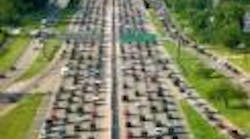“The intelligent vehicle and infrastructure technologies on display this week will save drivers precious time and hard-earned money by making travel safer and more convenient.” –Scott Belcher, president and CEO, Intelligent Transportation Society of America
There’s a ton of technology available today that could – and I stress the word “could” here – help not only alleviate a lot of the traffic congestion on our highways today, but also save fuel, money (in terms of vehicle maintenance costs) and that most precious of all commodities today, time. The best thing is most of the technologies I’m talking about – electronic tolls, “smart” traffic lights, and real-time routing using global positioning satellite (GPS) data -- all exist today and are well-tested. What we need now is a national strategy to deploy them in an orderly fashion and get people to use them.
Right now in Manhattan this week, the 15th World Congress on Intelligent Transportation Systems is showing off the potential of these technologies to transportation officials and industry leaders from the U.S. and more than 45 countries. “These technologies allow cars and roads to communicate with each other,” noted Scott Belcher, President and CEO of the Intelligent Transportation Society of America (ITS America). “They can prevent accidents before they happen, minimize traffic delays by reducing congestion and suggesting alternative routes based on real-time data, and even find you an available parking space.”
The point here is that technology today can play a multi-faceted role in helping alleviate a lot of transportation problems – both from the cars and commercial truck perspective. It’s not a silver bullet – nothing is these days – but deployed and used properly, technology can take a lot of pressure off freight and travel roadways in our country.
Consider these numbers: currently, a traffic accident occurs every five seconds on our roads killing over 42,000 Americans each year – equivalent to a full 737 flight crashing each day. Commuters waste more than seven million gallons of fuel daily, and the average rush hour commuter wastes almost a full work week each year stuck in traffic. The resulting financial cost to our economy exceeds $300 billion per year, said Randell Iwasaki, chairman of ITS America and chief deputy director of the California Department of Transportation (Caltrans).
“These unacceptable safety, environmental and congestions problems have solutions, and the answers often involve more effective use of technology,” he pointed out. “Technologies are readily available, and even more advanced solutions are on the way that will help commuters, transit operators, and commercial vehicles get where they need to go more safely, efficiently, and cost-effectively than has ever been dreamed of in the past.”
I talked with Charlotte Seigler, a spokeswoman for ITS America, about how difficulties involved in getting all these disparate technologies on the ground and working together seamlessly. “First of all, this technology is here and is already in use in pockets across the country – E-Z Pass for tollways on the east coast, GPS tracking for cars and trucks alike. So the excuse the technology doesn’t work is off the table,” she told me.
“The bottom line, though, is we need a national strategy to get the benefits out of it – not deploy these technologies piecemeal in different parts of the country,” Seigler explained. “It’s a matter of installing these systems in synch with the highway infrastructure.”
It might seem a little outlandish to rank sensor systems up there alongside concrete and asphalt in terms of infrastructure needs, but the benefits could be pretty significant, such as:
• Detecting traffic bottlenecks and then responding in real time by displaying travel advisories, changing speed limits, and altering traffic signal timing.
• Respond to crashes more quickly to save lives and prevent gridlock.
• Deploy maintenance crews in response to changing weather conditions – down to the exact street.
• Manage the regional transportation network to ensure optimum performance, efficiency and safety.
It’s not all solely about the roadways, either. Take new vehicle technology such as General Motor’s oil life monitoring (OLM) system, installed now on most of its cars. By tracking vehicle use habits and analyzing the resulting data within the vehicle’s onboard computers, engine oil life can be safely extended – saving money for the vehicle owner by reducing the need for oil changes, thus reducing petroleum consumption as well.
[Here’s a short video showing how GM’s OLM technology works. As they say, pictures – in this case moving pictures – are worth more than a thousand words.]
These are just some of the ways we can use technology to help us improve transportation as a whole in the U.S. What we need now is a national strategy to get everyone on the same page so we can fully maximize the benefits such technology offers.






